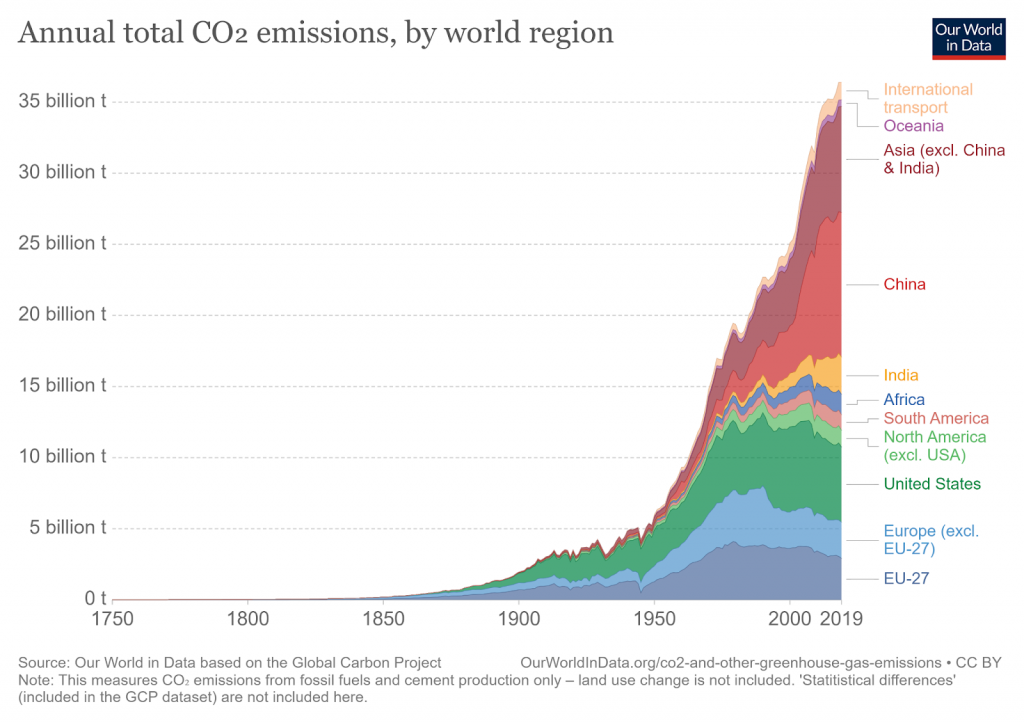What Are Carbon Offsets and How Do They Work
Impactful Ninja is reader-supported. When you buy through links on our site, we may earn an affiliate commission.
Learn more
Learn more
.
Hey fellow impactful ninja ? You may have noticed that Impactful Ninja is all about providing helpful information to make a positive impact on the world and society. And that we love to link back to where we found all the information for each of our posts. Most of these links are informational-based for you to check out their primary sources with one click. But some of these links are so-called "affiliate links" to products that we recommend. First and foremost, because we believe that they add value to you. For example, when we wrote a post about the environmental impact of long showers, we came across an EPA recommendation to use WaterSense showerheads. So we linked to where you can find them. Or, for many of our posts, we also link to our favorite books on that topic so that you can get a much more holistic overview than one single blog post could provide. And when there is an affiliate program for these products, we sign up for it. For example, as Amazon Associates, we earn from qualifying purchases. First, and most importantly, we still only recommend products that we believe add value for you. When you buy something through one of our affiliate links, we may earn a small commission - but at no additional costs to you. And when you buy something through a link that is not an affiliate link, we won’t receive any commission but we’ll still be happy to have helped you. When we find products that we believe add value to you and the seller has an affiliate program, we sign up for it. When you buy something through one of our affiliate links, we may earn a small commission (at no extra costs to you). And at this point in time, all money is reinvested in sharing the most helpful content with you. This includes all operating costs for running this site and the content creation itself. You may have noticed by the way Impactful Ninja is operated that money is not the driving factor behind it. It is a passion project of mine and I love to share helpful information with you to make a positive impact on the world and society. However, it's a project in that I invest a lot of time and also quite some money. Eventually, my dream is to one day turn this passion project into my full-time job and provide even more helpful information. But that's still a long time to go. Stay impactful,Affiliate Disclosure
Why do we add these product links?
What do these affiliate links mean for you?
What do these affiliate links mean for us?
What does this mean for me personally?
![]()
Our current global climate crisis threatens the environmental, economic, and social health of our planet. To ensure a sustainable planet for future generations we must take action now to reduce greenhouse gas (GHG) emissions and our carbon footprint. One of the ways we can do this is to implement carbon offsets. At least as part of our mitigation strategy. So we had to ask: What are carbon offsets and how do they work?
Carbon offsets are a way to invest in environmental projects that reduce carbon emissions in order to compensate for your own carbon footprint. Effective carbon offset projects are additional – meaning that they reduce carbon emissions more than would have occurred without them – and permanent.
Carbon offsets are a valuable tool to have in your climate mitigation toolbox. But what exactly are they? And how can you use them effectively? Continue reading to find out what carbon offsets are, how they work, and how you can implement them in your daily life.
The Big Picture of Carbon Offsets
We already have governmental-level policies in place to reduce GHGs, but how do we reduce emissions from activities where sustainable alternatives are not yet widely available? The answer just might be carbon offsets.
| Here’s what are carbon offsets are | Reductions in GHG emissions that are used to compensate for emissions occurring elsewhere |
| Here’s how carbon offsets work | You purchase offsets on behalf of a large corporation or on the voluntary market. Your money is used to fund projects that reduce GHG emissions |
| The main benefits of carbon offsets | Balancing off GHG emissions, improving air quality, maintaining healthy ecosystems, supporting green jobs |
| The main drawbacks of carbon offsets | Planting trees can’t replace cutting CO2 emissions, offsets are to a great extent PR schemes, and offsets often contribute to climate colonization |
To effectively use carbon offsets to reduce GHG emissions, we first must understand what they are.
What Are Carbon Offsets
Carbon offsets play an important role in mitigating the effects of global climate change by reducing greenhouse gas (GHG) emissions beyond what we each can achieve through individual actions.
“Carbon Offset: a way for a company or person to reduce the level of carbon dioxide for which they are responsible by paying money to a company that works to reduce the total amount produced in the world, for example by planting trees”
Oxford Dictionary
Carbon offsets play a crucial role in reducing our carbon footprint, the amount of CO2 emissions associated with an individual or an entity. The carbon footprint is one of the ways we measure the effects of human-induced global climate change. It primarily focuses on the greenhouse gas emissions associated with consumption, but also includes other emissions such as methane, nitrous oxide, and chlorofluorocarbons.

Globally, we pump over 36 billion tons of CO2 into the atmosphere every year which causes climate change, air pollution, acid rain, ocean acidification, and the melting of glaciers and polar ice. To ensure a healthy planet for future generations, we must reduce our CO2 emissions. And one way to do this is by using carbon offsets.
How Do Carbon Offsets Work
When you hear the words “carbon offset”, think about the term “compensation”. Essentially, carbon offsets are reductions in GHG emissions that are used to compensate for emissions occurring elsewhere. Because GHGs are found everywhere in our atmosphere, cutting GHGs at any location on earth provides emission reduction benefits.
Carbon offsets are designed for situations where emissions are impossible to reduce because you can use the funds to reduce emissions in other areas. Here are key criteria to look for in a carbon offset program:
- A clearly defined protocol that determines which types of projects are eligible and how emission reductions will be measured
- Independent third-party verification of compliance with the protocol
- Registration of offsets in an offset registry, which tracks each credit with a unique serial number to ensure it is only used once
- Transparency in project implementation and reporting
So, you’ve decided to offset your carbon footprint. Great start! Let us walk you through the most important steps next:
- Calculating your carbon footprint: To begin reducing CO2 emissions, we first must determine our individual carbon footprint. The United States Environmental Protection Agency (US EPA) provides a calculator so you can determine your carbon footprint in three areas: home energy, transportation, and waste. Everyone’s location, habits, and personal choices are different, so it is important to first know where you fall on the emissions scale so you can begin to reduce it.
- The most common carbon offset projects: The next step is to decide on a carbon offset project. When making this decision you want to consider in which area of your life you want to reduce carbon emissions and verify the reputation of the project, to ensure that it contains the key criteria listed above. Some of the most common offset programs involve aviation, renewable energy, energy efficiency, and carbon sequestration.
- Investing in carbon offsets: Once you’ve decided on an offset project, you can either purchase offsets on behalf of a large corporation or from an intermediary. Intermediaries could include organizations such as Terrapass, Native Energy, Green E, or Cool Effect.
- Your carbon offset impact: The market for offsets was small in the year 2000, but already by 2010 it grew to represent nearly $10 billion worldwide. And this number has been increasing ever since. So, what does this really mean about your carbon footprint? When implemented properly, carbon offsets can reduce your carbon footprint, which improves not only your own life, but the environmental, economic, and social state of the world.
How Do You Choose a Carbon Offset Program
When researching carbon offset projects, a good place to start is with the carbon offset project standards. These assure transparency and quality in the creation, quantification, and verification of offset projects. This way you can ensure that the project you eventually choose is actually reducing CO2 emissions.
- Verified Carbon Standard (VCS): Considered the world’s leading voluntary GHG program, with 1700+ projects having removed 630+ million tons of CO2 from the atmosphere. Examples of projects include hydropower in Turkey, forest conservation in Peru, and landfill gas capture in China.
- Gold Standard: A certification that seeks to maximize every dollar of climate and development funding. It has issued 134 million carbon credits from 1700+ projects based in more than 80 different countries. Examples of projects include solar power in India, efficient cooking and heating in China, and wind power in Indonesia.
- Climate Action Reserve (CAR): The premier carbon offset registry for the North American carbon market having issued over 150 million offset credits since its inception in 2001. Examples of projects include landfill gas capture in South Carolina and forest management in California.
- American Carbon Registry (ACR): The first private voluntary greenhouse gas registry in the world. Examples of projects include ozone-depleting substances in Arkansas and methane capture from mines in Kentucky.
Choosing carbon offset projects from any of the above project standard registries helps ensure that your project is verified and that it actually reduces CO2 emissions.
What Are the Most Common Carbon Offset Projects
Now that you know what to look for in a carbon offset project, you can choose a specific project. Carbon offsets can range anywhere from a couple of hundred tons of CO2 per program per year to thousands of tons of CO2 per program per year. Travel, renewable energy, energy efficiency, and carbon sequestration are just some of the areas that provide carbon offset projects.
- Aviation: Air travel accounts for approximately 1.9% of global GHG emissions and 2.5% of CO2 emissions. Roughly 40 airlines globally offer voluntary offsetting programs, where passengers pay more for a flight to fund projects that will reduce CO2 emissions.
- Renewable energy: The generation of energy from natural resources rather than from fossil fuels creates a reduction in GHG emissions. Solar and wind farms are common carbon offset projects. Renewable energy accounted for 11% of total global energy consumption in 2019, and this number is only expected to increase in the future.
- Energy Efficiency Improvements: These offset projects are designed to create products or systems that use less energy than conventional systems to perform the same task. Common projects include the widespread installation of LED light bulbs and efficient cooking stoves.
- Carbon Sequestration: Defined as the long-term storage of carbon in plants, soils, geologic formations, and the ocean. The Kyoto Protocol allows countries to receive credits for carbon-sequestration activities including afforestation, reforestation, improved forestry, improved agricultural practices, and revegetation.
What Impact Can You Have With Carbon Offsets
Carbon offsets reduce GHG emissions from coal, oil, and natural gas. Reducing your consumption of these, in turn, reduces your carbon footprint, which has huge impacts on environmental, economic, and public health. A reduced carbon footprint due to lower GHG emissions can mitigate the effects of climate change, improve public health, boost the economy, and maintain plant and animal diversity.
- Climate Change: Reducing your carbon footprint plays a role in mitigating the side effects of global climate change. The more we reduce the amount of GHG emissions, the more we slow the rate of temperature rise, sea-level rise, ice melting, and ocean acidification.
- Public Health: Reducing GHG emissions lessens the likelihood and severity of extreme weather events, improves air and water quality, maintains biodiversity, and supports a healthy food supply.
- Economics: Reducing GHG boosts the economy, especially when it becomes economically rewarding to innovate solutions that help protect our planet, fight climate change, and are based on clean energy.
- Plant and Animal Diversity: Healthy ecosystems have been linked with cleaner air, water, and food. Protecting forest habitats increases carbon sequestration and defends against erosion. Protecting agricultural land ensures a robust, secure, and prosperous food system. Protecting aquatic ecosystems ensures a readily available supply of freshwater. Lastly, protecting biodiversity protects human health because many plants and animals are used in modern medicines
Sounds great, right? Carbon offsets have the potential to instigate meaningful environmental change, but to make the greatest impact we must understand both their benefits AND drawbacks.
What Are the Main Benefits and Drawbacks of Carbon Offsets
Carbon offsets have benefits and drawbacks that are important to understand before you decide whether or not to purchase them. Supporters tout their ability to improve environmental health while opposers assert that they don’t really work.
What Are the Main Benefits of Carbon Offsets
To be beneficial, carbon offsets must be additional. That means that these projects must reduce GHG emissions more than would have occurred if there were no projects to begin with. They must also be permanent, in the sense that a tree planted to offset carbon should not be removed.
If – and only if – this is the case, then carbon offsets can help reduce your overall GHG emissions to balance off your personal carbon footprint to fight climate change – at least in the short term. But their benefits even go beyond that.
- Improves Air Quality: Degradation of air quality as a result of carbon emissions is a serious issue. In 2009, the U.S. government declared CO2, CH4, N2O, hydrofluorocarbons (HFCs), perfluorocarbons (PFCs), and sulfur hexafluoride (SF6) threats to the public health and welfare of current and future generations. Reducing C02 emissions would lead to improved public health in terms of asthma, respiratory allergies, airway diseases, and lung cancer.
- Protects Ecosystems: Healthy ecosystems have been linked with cleaner air, water, and food. Protecting forest habitats increases carbon sequestration and defends against erosion. Protecting agricultural land ensures a robust, secure, and prosperous food system. Protecting aquatic ecosystems ensures a readily available supply of freshwater. Lastly, protecting biodiversity protects human health because many plants and animals are used in modern medicines.
- Supports Green Jobs: The renewable energy sector employed 11.5 million people worldwide in 2019, with solar energy making up the bulk of those jobs. Renewable energy jobs continue to increase as we start to realize just how beneficial renewable energy is for our environment.
If used correctly, carbon offsets can provide environmental, economic, and social benefits that go beyond reducing GHG emissions.
What Are the Main Drawbacks of Carbon Offsets
The main argument against carbon offsets is that they don’t really work. Instead of substituting offsetting carbon emissions, we should instead cut the emissions directly at the source. Basically, if we stop emissions from getting into the atmosphere in the first place, we won’t have to worry about offsetting. Other arguments against offsets include:
- Planting Trees Can’t Replace Cutting CO2 Emissions: To offset even a fraction of our global CO2 emissions, we would have to plant AND protect a massive number of trees for decades. A newly planted tree could take upwards of 20 years to capture the amount of CO2 that a carbon offset program promises. Furthermore, there is always the risk of droughts, wildfires, tree diseases, and deforestation wiping out newly planted trees.
- Carbon offsetting plans are PR plans: Voluntary market offsets are often unregulated and come from a wide range of sources. Companies may advertise a specific program, but it may be just for public attention. This is why it is important to verify that a program is legitimate and accurately reported and measured.
- Climate Colonization: Most of the available land for reforestation carbon offset programs is located in poor countries. When powerful countries exploit this land, the native peoples are forced to compete for their basic needs, and they can even face food scarcity and eviction.
As with most things, carbon offsets have drawbacks that need to be understood before enrolling in a program. Proper verification and documentation can help ensure that the benefits of carbon offsets outweigh the drawbacks.
Final Thoughts
Carbon offsets allow us to reduce GHG emissions in ways we wouldn’t be able to accomplish individually. Offset programs involving aviation, renewable energy, energy efficiency, and carbon sequestration can reduce GHG emissions, which improves air quality, protects ecosystems, and supports green jobs. When implemented properly, these benefits can outweigh the drawbacks.
However, we can’t let carbon offsets be a guilt-free way to reduce GHG emissions. Offsets need to be used in conjunction with carbon reduction measures until the industry has time to invest, develop, and refine sustainable innovations.
So, are carbon offsets a long-term cure for global climate change? Not exactly. But in the short term, they can be effective in reducing GHG emissions!
Stay impactful,

Sources
- United Nations Framework Convention on Climate Change: The Paris Agreement
- David Suzuki Foundation: Are carbon offsets the answer to climate-altering flights?
- United States Environmental Protection Agency: Offsets and RECs: What’s the Difference?
- Impactful Ninja: Why Is a Carbon Footprint Bad for the Environment?
- Britannica: Carbon Footprint
- Our World in Data: Annual CO2 Emissions
- Britannica: Carbon Offset
- Natural Resources Defense Council: Carbon Offsets 101
- Terrapass: Buy carbon Offsets to Reduce Carbon Footprint
- Native Energy: Carbon Offset Providers
- Green E: Powering a Renewable Future
- Cool Effect: Carbon Done Correctly
- Terrapass: Project Standards
- Verra: Verified Carbon Standard
- Verra: Tepekisla Dam & Hydropower Plant Project
- Verra: The Jaguar Amazon Redd+ Project
- Verra: Sanya Landfill Gas Power Generation Project
- Gold Standard: Gold Standard Impact
- Climate Action Reserve: About Us
- Climate Action Reserve: Registry
- Climate Action Reserve: Bluesource – Berkeley County Landfill Gas Project
- Climate Action Reserve: Buckeye Forest Project
- American Carbon Registry: Our Mission
- American Carbon Registry: Registry
- American Carbon Registry: EOS Climate ODS destruction
- American Carbon Registry: Baker Mine AMM
- Earth.Org: How Airlines are Adopting Carbon Offsetting
- Our World in Data: Where in the world do people have the highest CO2 emissions from flying?
- US Energy Information Administration: Renewable Energy Explained
- Carbon Offset Guide: Energy Efficiency
- Britannica: Carbon Sequestration
- Britannica: Kyoto Protocol
- National Wildlife Federation: Climate Change
- National Institute of Environmental Health Sciences: Health Impacts of Climate
- Carbon Tax Center: What’s a Carbon Tax?
- One Green Planet: How Saving Wildlife Benefits Humans – In Ways We Really Need
- United States Environmental Protection Agency: Carbon Footprint Calculator
- United States Environmental Protection Agency: Endangerment and Cause or Contribute Findings for Greenhouse Gases under the Section 202(a) of the Clean Air Act
- National Institute of Environmental Health Sciences: Asthma, Respiratory Allergies and Airway Diseases
- National Institute of Environmental Health Sciences: Cancer
- Carbon Brief: Climate change will hit ‘endemic’ plants and animals the hardest, study warns
- One Green Planet: How Saving Wildlife Benefits Humans – In Ways We Really Need
- World Health Organization: Biodiversity and Health
- International Renewable Energy Agency: Renewable Energy Jobs Continue Growth to 11.5 Million Worldwide
- GreenPeace: The biggest problem with carbon offsetting is that it doesn’t really work
- Pacific Standard: How The Green New Deal Can Avoid Climate Colonialism




